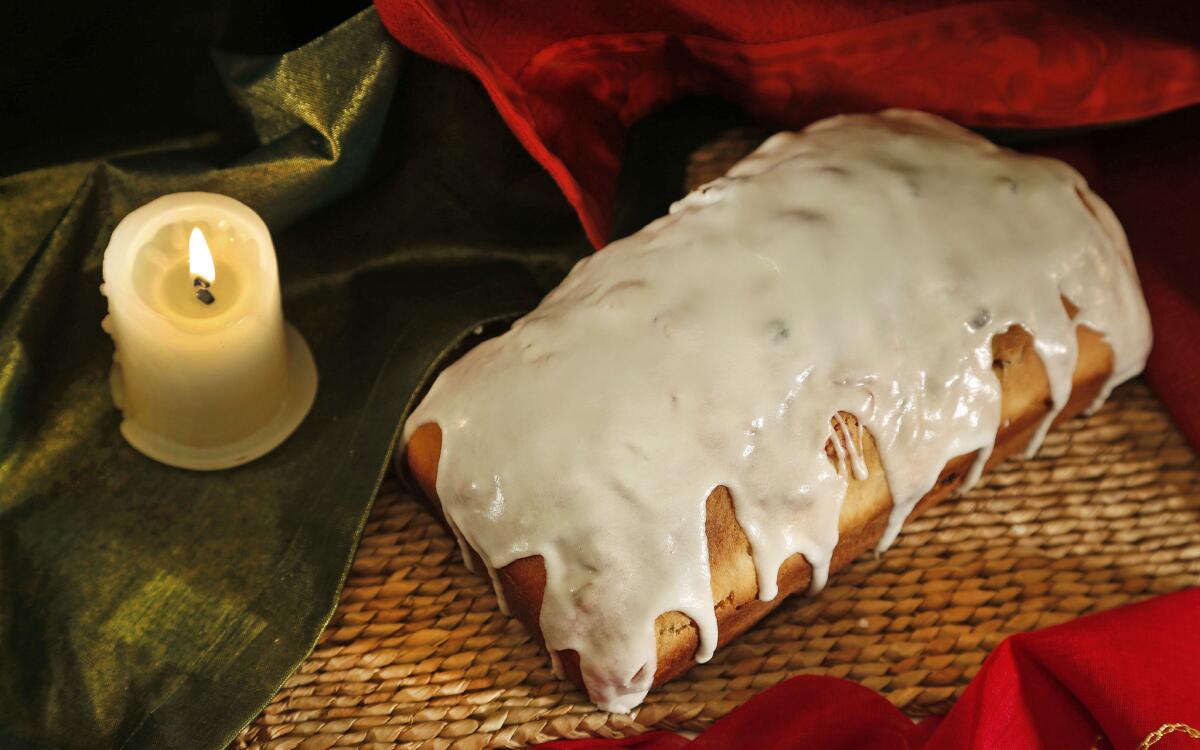Julekake

- Share via
Christmas breakfasts are meals of tradition in my family. Dinner, the rest of them pretty much let me play around however I want. But breakfast has to follow a certain script. Still, there are traditions, and then there are traditions.
A couple of years ago we were sitting around talking about what we were going to have for Christmas breakfast. Julekake, of course, is a given. A candied fruit-studded Scandinavian Christmas bread much loved in my father’s family, it’s probably been on my holiday table every year since I was born. The recipe I have comes from a tattered old community cookbook from a Methodist church in Fargo, N.D.
“And chilaquiles!” my daughter said. “Don’t forget the chilaquiles. We always have chilaquiles.”
I was dumbstruck. In fact, I couldn’t remember ever having fixed chilaquiles — for Christmas breakfast or any other time. It’s not that I have anything against chilaquiles; in fact, I quite like them. But somehow I just never got around to making them myself.
After much cajoling and reminding, I finally recalled that several years before, I had indeed fixed something vaguely chilaquile-ish for Christmas breakfast.
We’d been snowed in with a crowd of family in a house in the hills outside Santa Fe. We’d had a lot to eat and drink the night before and had planned on going out for breakfast. But with a foot of snow on the ground, that plan was off. So I scrambled through the kitchen, looking for anything I could put together to make a breakfast. Eggs, some green chiles, cheese, stale tortilla chips … gradually a plan began to form.
Well, really, there wasn’t that much of a plan — more like a pan, into which I threw ingredients as it seemed appropriate (remember, we had been up late the night before).
The funny thing was, what I wound up with was really pretty delicious. The hard-hearted among you might argue that anything that combines eggs, salsa, beans, tortillas, chile, cheese, cilantro and sour cream is almost bound to be good (and a thousand different breakfast burritos are pretty strong evidence that you’re right). But there was definitely something there.
Later I realized that what I had subconsciously done was re-create one of my old favorite hangover breakfasts from when I lived in Texas (and needed them more often) — migas. But those were well before my daughter’s time, and she just called my egg dish after the closest corollary she knew — chilaquiles.
Figuring out the history was only half the exercise, though. Then I was stuck with trying to replicate a dish that I’d thrown together in a haze several years before. Each Christmas I made it, it came out slightly different.
So this winter I determined that I would finally come up with the one, true, official version. It took a few passes, but what I finally settled on is eggs scrambled with green onions and chopped green chile (you can substitute salsa, if you prefer). When the eggs have just started to set, fold in tortilla chips (the staler the better) and some salty cotija cheese. Cook the eggs fairly quickly so the chips retain some of their crispness. When the eggs are done, top with some black beans, more cheese, Mexican sour cream and chopped cilantro.
It’s got pretty much everything you want in a breakfast — Christmas or not — and while it’s probably not the most traditional match for julekake (lutefisk and lefse anyone?), from now on it will be part of our tradition nonetheless.
In a saucepan over medium-high heat, scald the milk. Remove from heat and add the sugar and shortening. Cool to lukewarm. Add yeast and set aside for 5 minutes to activate the yeast. Stir in 3 cups flour, beat, then add the salt and eggs and beat again. Add cherries and orange peel, raisins and currants. Stir in the remaining flour.
On a lightly floured board, knead well until smooth and elastic, about 5 minutes. Place the dough in an oiled bowl and cover loosely with plastic wrap; set aside in a warm place until the dough is doubled. Punch the dough down and let double again.
Heat the oven to 375 degrees. Divide the dough in half and place each half in a greased 9-inch by 5-inch loaf pan. Bake until browned on top, 25 to 30 minutes. Cool on a rack before icing.
Icing
In a small bowl, beat the milk with the powdered sugar until the frosting is thick enough to spread. Add the butter and continue to beat several minutes until very creamy. Spoon over top of cooled loaves and let dribble down the sides.
Get our Cooking newsletter.
Your roundup of inspiring recipes and kitchen tricks.
You may occasionally receive promotional content from the Los Angeles Times.
















